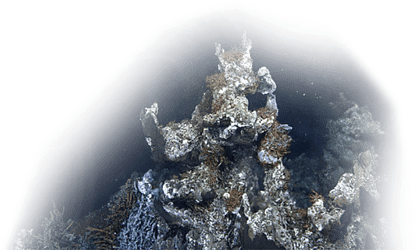Composer & percussionist Colin Malloy is the 2022 Ocean Networks Canada artist-in-residence.
January 19, 2023 - John Threlfall
Read the University of Victoria story here. Reprinted with permission.
Our world is saturated by oil. From fuel and plastic to climate change and the global economy, oil affects every aspect of human existence — right down to the microscopic level. And for 2022 Ocean Networks Canada artist-in-residence Colin Malloy, oil not only provided the inspiration for his residency, it’s also had a direct influence on the instrument he plays.
As well as being an interdisciplinary music technology PhD candidate with UVic’s School of Music & the Department of Computer Science, Malloy is an award-winning percussionist and composer who plays the Caribbean steelpan: also known as a steel drum, it’s an iconic instrument that wouldn’t exist without oil.
“After WWII, there were lots of leftover oil barrels from the US and British navies in Trinidad, so people adapted those into instruments: they cut up the barrels and, with a lot of hammering, made the modern steelpans out of them,” Malloy explains, noting that the majority of today’s steelpans are still made from 55-gallon barrels (“just ones that haven’t had oil in them”).
“Since it’s an oil-producing nation, the steelpan is a huge part of the country — it’s Trinidad’s national instrument, and they have hundreds of steel bands, most of which are sponsored by the oil industry. Because the steelpan has such an intrinsic connection to oil, I thought that was a natural lens through which to analyze how it affects the ocean.”
Working with oil & water
Over the course of his four-month residency, Malloy met with ONC scientists and examined ocean data in order to create a series of new electroacoustic percussion compositions, which he’ll be performing live on January 26 under the title of Oil & Water.
“Given the steelpan’s history, I had a clear idea from the start of my proposal — I’m looking at how the effects of oil are inextricably linked to climate change,” he says.
Fusing his passion for percussion and audio programming, Malloy has composed four pieces inspired by ONC data sets. His piece titled “Oil & Water”, for example, uses software that probabilistically generates tones representing the data set for world oil production over the last 120 years.
“It starts out with a nice, meditative melody coming from the steelpan . . . but the sound gets louder and more aggressive and more intrusive until it eventually overpowers the performer,” he says. A synthesizer cycles the information into sound, with different data sets emerging as different musical timbres.
“It’s more an artistic choice reinforcing the connection between the music and the scientific ideas,” Malloy explains. “By using data to drive the music, it will hopefully lead audiences to reflect on how our own daily use of oil affects the ocean. People’s minds and feelings are changed through stories and emotions, not through data, but I do want everything I do to be informed by actual data — it’s important for my music to reflect truth and accuracy, to have integrity.
Sounds of science
During his residency, Malloy says ONC researchers exposed him to “a lot of information that was just on the edge of my awareness” — like the problematic Great Pacific Garbage Patch, the swirling plastic trash vortex which scientists estimate covers a staggering 1.6 million square kilometers in the North Pacific (an area twice the size of Texas or three times that of France).
“I learned that it’s basically a collection of all kinds of plastic in the ocean, which is so insidious because it’s effectively forever: plastic doesn’t biodegrade, it just breaks down into smaller pieces until it’s microscopic — so the patch is effectively a thick, giant plastic floating slurry that light can’t penetrate, that traps heat and contributes to ocean warming, that harms the fish and wildlife and the overall ecosystem . . . none of which I envisioned.”
This inspired another composition titled “Trash Vortex”, for which Malloy created his own interactive software.
“Recordings of all my previous rehearsals and performances are being constantly played back by the computer while being broken into smaller and smaller pieces, which I’ll be playing overtop of,” he explains. “It’s like the ‘trash’ of my previous work has become a metaphorical framework for an improvisation . . . the score is essentially the software, which changes every time, so what I play in response will be a different experience each time.”
A third piece is titled “Hot, Sour and Breathless”, which offers a musical interpretation of the projected future of the oceans as a result of climate change: “hot” representing warming temperatures, “sour” being the changing pH levels as the waters become more acidic, and “breathless” standing in for the deoxygenation of the oceans — all concerns Malloy learned about during his residency.
An emotional connection
With plans to record his ONC compositions later this spring, Malloy also hopes to return to some of the ideas he didn’t have time to explore. “The variety of sounds whales make are incredible,” he says by way of example. “I really wanted to find a way to mimic them: percussionists like finding weird, interesting ways of making new sounds!”
Ultimately, he hopes listeners will find a more personal connection between the sounds and the science.
“With music, people come to a concert prepared to have an intellectual or emotional reaction: you’re not necessarily going to understand the data better by hearing these pieces, but it might affect you differently than hearing something on the news,” he says.
“I’ve learned a lot through this process and I’m hoping to share that with the audience. It’s been a real educational experience for me.”
Colin Malloy’s “Reflection in Waves”, written for Radio Amnion, a multi-year sound art project for the waters of Earth, commissioning new compositions by contemporary artists: these are then relayed more than two kilometres deep within the Pacific Ocean during each full moon.
